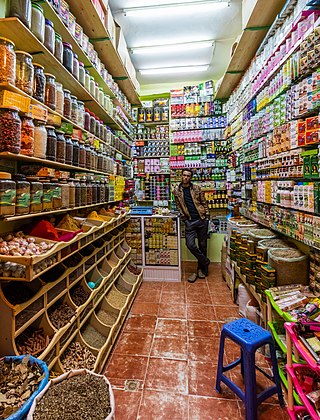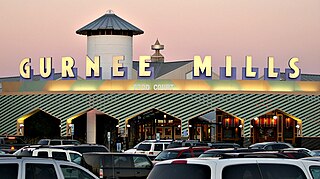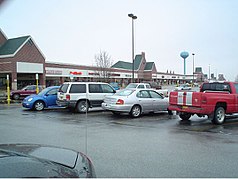
Shopping is an activity in which a customer browses the available goods or services presented by one or more retailers with the potential intent to purchase a suitable selection of them. A typology of shopper types has been developed by scholars which identifies one group of shoppers as recreational shoppers, that is, those who enjoy shopping and view it as a leisure activity.

Retail is the sale of goods and services to consumers, in contrast to wholesaling, which is sale to business or institutional customers. A retailer purchases goods in large quantities from manufacturers, directly or through a wholesaler, and then sells in smaller quantities to consumers for a profit. Retailers are the final link in the supply chain from producers to consumers.

Nordstrom, Inc. is an American luxury department store chain headquartered in Seattle, Washington, and founded by John W. Nordstrom and Carl F. Wallin in 1901. The original Wallin & Nordstrom store operated exclusively as a shoe store, and a second Nordstrom's shoe store opened in 1923. The growing Nordstrom Best chain began selling clothing in 1963, and became the Nordstrom full-line retailer that presently exists by 1971. The company founded its off-price Nordstrom Rack division in 1973, and grew both full-line and off-price divisions throughout the United States in the following years. The full-line division competes with department stores including Bloomingdale's, Macy's, Neiman Marcus, and Saks Fifth Avenue, while the off-price division competes with retailers including the TJX Companies and Ross Stores. Previous expansions beyond the contiguous United States include Puerto Rico (2015–2020) and Canada (2014–2023).

Sears, Roebuck and Co., commonly known as Sears, is an American chain of department stores founded in 1892 by Richard Warren Sears and Alvah Curtis Roebuck and reincorporated in 1906 by Richard Sears and Julius Rosenwald, with what began as a mail ordering catalog company migrating to opening retail locations in 1925, the first in Chicago. In 2005, the company was bought by the management of the American big box discount chain Kmart, which upon completion of the merger, formed Sears Holdings. Through the 1980s, Sears was the largest retailer in the United States. In 2018, it was the 31st-largest. After several years of declining sales, Sears's parent company filed for Chapter 11 bankruptcy on October 15, 2018. It announced on January 16, 2019, that it had won its bankruptcy auction, and that a reduced number of 425 stores would remain open, including 223 Sears stores.

A variety store is a retail store that sells general merchandise, such as apparel, auto parts, dry goods, toys, hardware, furniture, and a selection of groceries. It usually sells them at discounted prices, sometimes at one or several fixed price points, such as one dollar, or historically, five and ten cents. Variety stores, as a category, are different from general merchandise superstores, hypermarkets, warehouse clubs, grocery stores, or department stores.

Penney OpCo LLC, doing business as JCPenney and often abbreviated JCP, is an American department store chain that operates 663 stores across 49 U.S. states and Puerto Rico. Departments inside JCPenney stores include Men's, Women's, Boys', Girls', Baby, Bedding, Home, Fine Jewelry, Shoes, Lingerie, JCPenney Salon, JCPenney Beauty, as well as leased departments such as Seattle's Best Coffee, US Vision optical centers, and Lifetouch portrait studios.

Harold Alfond was an American businessman who founded the Dexter Shoe Company and established the first factory outlet store.
A discount store or discounter offers a retail format in which products are sold at prices that are in principle lower than an actual or supposed "full retail price". Discounters rely on bulk purchasing and efficient distribution to keep down costs.

A big-box store is a physically large retail establishment, usually part of a chain of stores. The term sometimes also refers, by extension, to the company that operates the store. The term "big-box" references the typical appearance of buildings occupied by such stores.

Sawgrass Mills is a 1/5 star shopping mall in Sunrise, Florida, owned by Simon Property Group. With 2,370,610 square feet (220,237 m2) of retail selling space, it is the eleventh largest mall in the United States, the largest single story outlet mall in the U.S., the largest shopping mall in Broward County, the second largest mall in Florida and the Miami metropolitan area after the Aventura Mall, and the third largest shopping mall in the southeastern United States. With over 21 million annual visitors, Sawgrass Mills is one of the most visited attractions in the state of Florida.
Famous Footwear is a nationwide chain of retail stores in the United States dealing in branded footwear, generally at prices discounted from manufacturer's suggested prices. The chain is a division of the St. Louis–based Caleres and had more than 1,125 stores in 2010.
The Shoppes at South Hills, formerly South Hills Mall, was a shopping mall on U.S. 9, now converted into a strip mall, in the town of Poughkeepsie, New York. The 675,000 ft² plaza opened in 1974 and included two anchors, Sears and Kmart, at opposite ends of the mall. Currently, The Shoppes at South Hills are owned and operated by DLC Management Corporation.
Poundland is a British variety store chain founded in 1990. It once sold most items at the single price of £1, including clearance items and proprietary brands. The first pilot store opened in December 1990 following numerous rejections by landlords who had reservations about allowing a single-price store to operate, fearing it could adversely affect the local competition. An estimated 7 million customers shopped in Poundland every week in 2016, many being female shoppers in the C1, C2, D and E categories. Following a drop in share price of over 50%, Poundland was acquired in August 2016 by Steinhoff International for £610 million.
Steve & Barry's was an American retail clothing chain, featuring casual clothing, footwear and accessories. Headquartered in Port Washington, New York, the chain operated 276 stores in 39 states before liquidating throughout 2008 and 2009.

Gurnee Mills is a shopping mall and outlet mall in Gurnee, Illinois, within the Chicago metropolitan area. Like the nearby Six Flags Great America and Great Wolf Lodge, the mall's placement in Gurnee is intended to bring customers from both Chicago and Milwaukee, Wisconsin. With 1,936,699 square feet (179,925 m2) of gross leasable area and ten major anchor stores in its Z-shaped single-story building, it is the third largest mall in Illinois, and the largest of the four enclosed shopping centers in Lake County. Owned and operated by the Simon Property Group, it was an early part of the "Landmark Mills" chain of shopping malls built by the Mills Corporation. The mall features Hobby Lobby, Macy's, Kohl's, Marshalls/HomeGoods, Value City Furniture, Bass Pro Shops Outdoor World, Off Broadway Shoe Warehouse, Forever 21, H&M, Dick's Sporting Goods, Marcus Theatres, Rainforest Cafe, Top Shelf Ice Arena, The RoomPlace, Lee Wrangler Clearance Center, Burlington Coat Factory, and Floor & Decor as its anchor tenants.

Vanity, also known as Vanity Shops, was an American specialty chain of fashion retailers that sold apparel and accessories targeted to fashion-conscious young females, online and in stores. The company was headquartered in Fargo, North Dakota. The fashion retailer's clothing items ranged in size from zero to 17 with pants inseam lengths of up to 37 inches (940 mm). Vanity filed for bankruptcy and closed its stores in 2017.
Off-price is a trading format based on discount pricing. Off-price retailers are independent of manufacturers and buy large volumes of branded goods directly from them. The off-price retail model relies on the purchase of over-produced, or excess, branded goods at a lower price, thus being able to sell to consumers at a discount compared to other stores which purchased an initial run. Among the largest retailers of this type are TJX Companies and Ross Stores. The model is more common in countries that import fashion-oriented or household goods, as the discount role in producer countries is usually filled by factory outlets or small-scale open-air marketplaces.
Edison Brothers Stores, Inc., was a retail conglomerate based in St. Louis, Missouri. It operated numerous retail chains mainly located in shopping malls, mostly in the fields of shoes, clothing and entertainment, with Bakers Shoes as its flagship chain. The company was liquidated in 1999, though some of the chains it operated continued under different owners.
The retail format influences the consumer's store choice and addresses the consumer's expectations. At its most basic level, a retail format is a simple marketplace, that is; a location where goods and services are exchanged. In some parts of the world, the retail sector is still dominated by small family-run stores, but large retail chains are increasingly dominating the sector, because they can exert considerable buying power and pass on the savings in the form of lower prices. Many of these large retail chains also produce their own private labels which compete alongside manufacturer brands. Considerable consolidation of retail stores has changed the retail landscape, transferring power away from wholesalers and into the hands of the large retail chains.

The Outlets At Montehiedra, formerly known as the Montehiedra Town Center, is an enclosed shopping mall in San Juan, Puerto Rico. Anchor stores for the mall are a Marshalls MegaStore, Burlington, Old Navy, and a Home Depot as an out parcel. The former Kmart, which served as an anchor to the mall from the very beginning which closed in 2021, has found replacement primarily by a Ralph's Food Warehouse and a TJ Maxx. It was also formerly anchored by a Tiendas Capri which closed in 2024, now being replaced by a Burlington. The mall additionally features a 14-screen Caribbean Cinemas.













